This blog post is the first in a series on the creation of a small I18n application using Phoenix LiveView, which updates page content based on the language chosen from a dropdown menu:
- Internationalisation with Phoenix LiveView
- Internationalisation with Phoenix LiveComponents
- Internationalisation with Phoenix Live Layouts
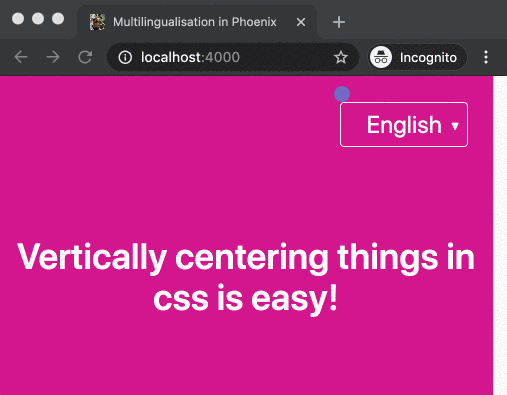
In a previous blog post, Runtime Language Switching in Elm, I re-created the Tachyons Full Screen Centered Title component documentation page in Elm, and added a language dropdown menu to change the page language.
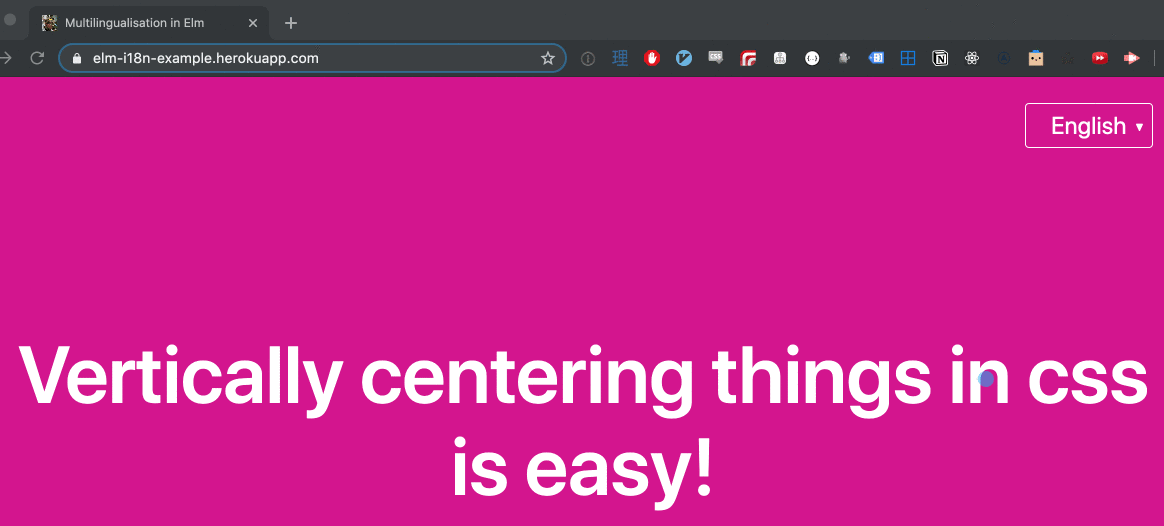
You can find the code here, but to save a click, the animated GIF above shows all of its use cases:
- Click on the current language, and the menu opens, showing a list of selectable languages
- Click the current language again, or anywhere else on the page, and the menu closes
- If you select a different language, the language of the page content and title will change, and the list of selectable languages in the dropdown menu will update
- Refresh the page, and you will see that your choice of language is remembered
The blog post goes through different methods I used to get internationalisation (i18n) working, but, in my opinion, the options in Elm as of this writing are not quite as nice as Elixir’s gettext-based API.
However, when I have previously implemented language switching for a standard Phoenix application, compared with frontend-only Elm, needing to make a request back to the server to change the application locale means that a bit more time is needed before the update is visible on screen.
Granted, changing application locale is not something a typical user would perform very often, and so, needing a page refresh for it is probably not a pain point for anyone. But, with the advent of Phoenix LiveView, I wondered whether I would be able to exactly replicate the snappiness of the Elm example application with Phoenix, just for fun.
And so, the rest of this post will focus on porting over/re-creating the Elm application in Phoenix, evolving over four stages:
- Straight client-server
- Augmenting client-server with Javascript “sprinkles”
- Letting Javascript take over
- Swapping out Javascript for LiveView
The software versions we will use to build out this application are:
- Elixir: 1.9.2
- Erlang: 22.0.7
- Phoenix: 1.4.10
- Gettext: 0.7.10
- LiveView: 0.3.1
- Node: 12.12.0
- Tachyons: 4.11.1
Let’s get started!
Initial Setup
No Ecto
Generate and install dependencies of a new Phoenix application. We will not be using a database, so pass in the --no-ecto flag to make sure we do not generate any unneeded Ecto configuration:
mix phx.new phx_i18n_example --no-ecto
cd phx_i18n_example
mix deps.get
Gettext
Next, we will need to tell Gettext about what locales we want to use in the application (in our case English, Italian, and Japanese), and what locale should be the default (English). Add the following lines to your configuration:
config/config.exs
config :phx_i18n_example, PhxI18nExampleWeb.Gettext,
default_locale: "en",
locales: ~w(en it ja)
Tachyons
Since we will use Tachyons for styling, we have to install it and make it available in Phoenix.
First, install it with npm:
npm install --save-dev tachyons@4.11.1 --prefix assets
Then, import it into Phoenix:
assets/js/app.js
// ...
// import css from "../css/app.css"
// ...
import "phoenix_html"
import "tachyons"
// ...
Make sure you also comment out or remove the default Phoenix-generated import css from "../css/app.css" line since we will not be using those default styles, and we do not want anything in app.css to overwrite Tachyons styling.
Client-Server
Dealing with Params
For this first development step, the goal will be to go as far as we can in building out the main use cases of the application using just Phoenix, and no Javascript. This means we will have to start using URL parameters to send information to the server in order to tell it about the desired state of the application.
For example, if we want the locale to be Japanese, we could send a locale URL parameter to tell the application to switch to Japanese:
http://localhost:4000/?locale=ja
Since we are not using Javascript, we will also have to use URL parameters to let the application know if we want to open or close the locale dropdown menu:
http://localhost:4000/?show_available_locales=true
http://localhost:4000/?show_available_locales=false
I think the best way for dealing with these parameters as they come in to the application is to use a Plug, so let’s add a LocalePlug to our :browser pipeline:
lib/phx_i18n_example_web/router.ex
defmodule PhxI18nExampleWeb.Router do
use PhxI18nExampleWeb, :router
alias PhxI18nExampleWeb.LocalePlug
pipeline :browser do
# ...
plug LocalePlug
end
# ...
end
We need this LocalePlug to do the following:
- Fetch and set the locale:
- First, check the parameters for the locale
- If it cannot be found in the parameters, check the browser cookies
- If it cannot be found in the browser cookies, return the default locale
- Update the global application locale to the retrieved locale value, but only if that locale value is actually different to the global application locale
- Determine the dropdown menu state:
- If the parameters have a
show_available_locales=truevalue, indicate that the dropdown should be open - If there is any other value for
show_available_locales, includingfalse, or ifshow_available_localesis not present in the params, the dropdown should display as closed
- If the parameters have a
- Persist the locale in the cookies
- If the locale value is already stored in the cookie, do nothing
- Otherwise, if the cookie value is different from the locale value, or the cookie value is not present, store the locale value in the cookie
Let’s see what this looks like in code:
lib/phx_i18n_example_web/plugs/locale_plug.ex
defmodule PhxI18nExampleWeb.LocalePlug do
alias Plug.Conn
@behaviour Plug
@locales Gettext.known_locales(PhxI18nExampleWeb.Gettext)
@cookie "phxi18nexamplelanguage"
@ten_days 10 * 24 * 60 * 60
defguard known_locale?(locale) when locale in @locales
@impl Plug
def init(_opts), do: nil
@impl Plug
def call(conn, _opts) do
locale = fetch_and_set_locale(conn)
conn
|> determine_language_dropdown_state()
|> persist_locale(locale)
end
defp fetch_and_set_locale(conn) do
case locale_from_params(conn) || locale_from_cookies(conn) do
nil ->
# This will fallback to the default locale set in `config.exs`
Gettext.get_locale()
locale ->
# Update the global locale only if the `locale` value
# is different to it
if locale != Gettext.get_locale() do
Gettext.put_locale(locale)
end
locale
end
end
defp locale_from_params(%Conn{params: %{"locale" => locale}})
when known_locale?(locale) do
locale
end
defp locale_from_params(_conn), do: nil
defp locale_from_cookies(%Conn{cookies: %{@cookie => locale}})
when known_locale?(locale) do
locale
end
defp locale_from_cookies(_conn), do: nil
defp determine_language_dropdown_state(conn) do
show_available_languages =
case conn.params["show_available_locales"] do
"true" ->
true
_ ->
# `false`, `nil`, `blah` etc
false
end
Conn.assign(conn, :show_available_locales, show_available_languages)
end
defp persist_locale(%Conn{cookies: %{@cookie => locale}} = conn, locale) do
# Cookie locale is the same as the current locale, so do nothing and just
# return the original `conn`
conn
end
defp persist_locale(conn, locale) do
Conn.put_resp_cookie(conn, @cookie, locale, max_age: @ten_days)
end
end
A few notes on this Plug file:
- We are using
Gettext.get_locale/0as the source of truth for the application locale. It “gets the global Gettext locale for the current process”, and since we’re doing a single process client-server implementation, it suits our purposes. There is no need toassigna separatelocalevalue in theconn: whenever we want the application locale, we will ask Gettext to provide it to us - We are following Elixir’s rule of thumb and deliberately using
||, and notor, infetch_and_set_locale/1, since the values returned on either side are non-boolean - Having the cookie be valid for ten days is completely arbitrary. Feel free to change as you see fit
From Route to Template
Now that we have our application state set up, our flow from here towards the view layer is exactly as Phoenix provides out-of-the-box:
The root path gets routed to the PageController:
lib/phx_i18n_example_web/router.ex
defmodule PhxI18nExampleWeb.Router do
use PhxI18nExampleWeb, :router
alias PhxI18nExampleWeb.LocalePlug
pipeline :browser do
# ...
plug LocalePlug
end
# ...
scope "/", PhxI18nExampleWeb do
pipe_through :browser
get "/", PageController, :index
end
end
Then, the PageController renders the index.html template:
lib/phx_i18n_example_web/controllers/page_controller.ex
defmodule PhxI18nExampleWeb.PageController do
use PhxI18nExampleWeb, :controller
def index(conn, _params) do
render(conn, "index.html")
end
end
…which we need to change to the following code:
lib/phx_i18n_example_web/templates/page/index.html.eex
<article class="<%= article() %>">
<div class="<%= heading_container() %>">
<h1 class="<%= heading() %>">
<%= gettext("Vertically centering things in css is easy!") %>
</h1>
</div>
</article>
- The Phoenix-generated
lib/phx_i18n_example_web/gettext.exfile enables us to use agettextmacro to search for translated strings depending on the Gettext locale setting. We do not have any translations at the moment, so this call will just return the “Vertically centering things in css is easy!” string itself (we will get to generating translations later) - All the functions that you see interpolated in the various tag
classattribute values exist to make it easier for us to manage sets of Tachyons utility classes
Modules Specifically for Styling
Functions declared without qualified module names in templates will be attempted to be resolved in the view that renders them, which, in index.html.eex’s case, as per Phoenix convention, is the PageView.
Since the functions that are being referenced here will all thematically relate to styling, and be quite verbose, I think we should put them inside their own specific “style” modules, and have PageView delegate to them. This, to me at least, makes the PageView explicitly say:
“I know I am meant to respond to these functions, but their details are not my responsibility, so please go and look in this other module”
lib/phx_i18n_example_web/views/page_view.ex
defmodule PhxI18nExampleWeb.PageView do
use PhxI18nExampleWeb, :view
alias PhxI18nExampleWeb.PageStyle
defdelegate article, to: PageStyle
defdelegate heading, to: PageStyle
defdelegate heading_container, to: PageStyle
end
lib/phx_i18n_example_web/views/styles/page_style.ex
defmodule PhxI18nExampleWeb.PageStyle do
@article_classes ~w[
dt
vh-75
w-100
] |> Enum.join(" ")
@heading_container_classes ~w[
dtc
ph-3 ph4-l
tc
v-mid
] |> Enum.join(" ")
@heading_classes ~w[
f6 f2-m f-subheadline-l
fw6
tc
] |> Enum.join(" ")
def article, do: @article_classes
def heading_container, do: @heading_container_classes
def heading, do: @heading_classes
end
- In order to make the Tachyons mnemonics easier to manage, they are in lists contained in module attributes, which get joined into a single string at compile time
- The attributes are then wrapped in functions so they become a part of the module’s public interface
I think this is a nicer way to deal with CSS utility classes, rather than modify them directly in a template. But, as with any subjective opinion, your mileage may vary.
Page Layout
Now, every template gets rendered inside of a layout, so let’s look at the main application layout next, and mark where we will make changes from the Phoenix-generated defaults:
lib/phx_i18n_example_web/templates/layout/app.html.eex
<!DOCTYPE html>
<html>
<head>
<!-- ... -->
<title><%= gettext("Multilingualisation in Phoenix") %></title>
<!-- ... -->
</head>
<body class="<%= body() %>">
<%= render LanguageDropdownView,
"language_dropdown.html",
show_available_locales: @show_available_locales %>
<main role="main">
<%= render @view_module, @view_template, assigns %>
</main>
<!-- ... -->
</body>
</html>
Like the index.html.eex template, the <title> uses the gettext macro to get its translation, and the <body> calls out to a body/0 view function in LayoutView to fetch its Tachyons style classes:
lib/phx_i18n_example_web/views/layout_view.ex
defmodule PhxI18nExampleWeb.LayoutView do
use PhxI18nExampleWeb, :view
alias PhxI18nExampleWeb.{LanguageDropdownView, LayoutStyle}
defdelegate body, to: LayoutStyle
end
lib/phx_i18n_example_web/views/styles/layout_style.ex
defmodule PhxI18nExampleWeb.LayoutStyle do
@body_classes ~w[
bg-dark-pink
overflow-container
pt3
sans-serif
vh-100
white
] |> Enum.join(" ")
def body, do: @body_classes
end
Language Dropdown Menu
Above the main section of app.html.eex, within which in this case index.html.eex is rendered, we render a separate view and template for the locale dropdown, passing in a @show_available_locales value, available here as a module attribute due to show_available_locales being assigned in the Plug.Conn in LocalePlug:
lib/phx_i18n_example_web/templates/language_dropdown/language_dropdown.html.eex
<div class="<%= dropdown_container() %>">
<%= render LanguageDropdownView,
"_current_locale_link.html",
show_available_locales: @show_available_locales %>
<ul class="<%= dropdown_list(@show_available_locales) %>">
<%= render_many selectable_locales(),
LanguageDropdownView,
"_locale_link.html",
as: :locale %>
</ul>
</div>
Using the same LanguageDropdownView, we render two partial templates:
-
_current_locale_link.html, passing in the@show_available_localesvalue we received fromapp.html.eex -
_locale_link.html, which we are rendering for each of the non-current selectable locales, which we get from theselectable_locales/0function, usingPhoenix.View.render_many/4
Let’s have a look at each of the partial templates:
lib/phx_i18n_example_web/templates/language_dropdown/_current_locale_link.html.eex
<a href="?show_available_locales=<%= !@show_available_locales %>"
class="<%= current_selection_link() %>">
<p class="<%= current_selection(@show_available_locales) %>">
<span><%= current_locale_string() %></span>
<span class="<%= caret() %>">▾</span>
</p>
</a>
- The
<a>tag here links to the opposite value of whatever the passed-in@show_available_localesvalue is, so that we can implement a toggle-like action - The styling of the dropdown is dependant on the value in
@show_available_locales, which gets passed into thecurrent_selection/1function
lib/phx_i18n_example_web/templates/language_dropdown/_locale_link.html.eex
<a href="?locale=<%= @locale %>" class="<%= dropdown_list_item_link() %>">
<li class="<%= dropdown_list_item() %>">
<%= locale_string(@locale) %>
</li>
</a>
- The
@localeattribute comes from theas: :localeoption used in therender_many/4function inlanguage_dropdown.html.eex: each locale from theselectable_locales/0function (see below) that is passed in to the partial is referenced as@locale - The
<a>tag here links to its own locale as the target locale - Displays the humanised version of the locale (eg locale
"en"displays as “English”)
All the functions in the previous two partial templates are contained in the LanguageDropdownView:
lib/phx_i18n_example_web/views/language_dropdown_view.ex
defmodule PhxI18nExampleWeb.LanguageDropdownView do
use PhxI18nExampleWeb, :view
alias PhxI18nExampleWeb.LanguageDropdownStyle
alias __MODULE__, as: LanguageDropdownView
@locales Gettext.known_locales(PhxI18nExampleWeb.Gettext)
@locale_strings %{
"en" => "English",
"it" => "Italiano",
"ja" => "日本語"
}
defdelegate caret, to: LanguageDropdownStyle
defdelegate current_selection(show_available_locales), to: LanguageDropdownStyle
defdelegate current_selection_link, to: LanguageDropdownStyle
defdelegate dropdown_container, to: LanguageDropdownStyle
defdelegate dropdown_list(show_available_locales), to: LanguageDropdownStyle
defdelegate dropdown_list_item, to: LanguageDropdownStyle
defdelegate dropdown_list_item_link, to: LanguageDropdownStyle
def locale_string(locale), do: @locale_strings[locale]
def current_locale_string, do: locale_string(Gettext.get_locale())
def selectable_locales, do: List.delete(@locales, Gettext.get_locale())
end
- The Tachyons style-related functions are all delegated off to this view’s style module,
LanguageDropdownStyle - The
locale_string/1andcurrent_locale_string/0functions simply perform a lookup of the@locale_stringsmap to get the value to show in the menu: note that these strings are static, and the menu itself is not internationalised at all - Notice that the
current_locale_string/0function immediately calls thelocale_string/1function, passing in the result of theGettext.get_locale/0function as a parameter: we are always using Gettext as the source of truth for the application locale - In the same way, to get the list of selectable locales to populate the locale menu, we are subtracting the current locale from the list of known locales that we configured in
config.exs
The LanguageDropdownStyle module contains the following:
lib/phx_i18n_example_web/views/styles/language_dropdown_style.ex
defmodule PhxI18nExampleWeb.LanguageDropdownStyle do
@caret_classes ~w[
absolute
ml2
] |> Enum.join(" ")
@current_selection_classes ~w[
b--white
ba
br2
pa2
pointer
tc
w4
]
@current_selection_border_radius_classes "br--top"
@current_selection_link_classes ~w[
no-underline
white
] |> Enum.join(" ")
@dropdown_container_classes ~w[
center
f3
flex
h3
items-center
justify-end
w-90
] |> Enum.join(" ")
@dropdown_list_classes ~w[
absolute
b--white
bb
bl
br
br--bottom
br2
items-center
list
mt5
pl0
pointer
pr0
pt1
tc
top-0
w4
]
@dropdown_show_classes ~w[
flex
flex-column
] |> Enum.join(" ")
@dropdown_hide_classes "dn"
@dropdown_list_item_classes ~w[
hover-bg-white
hover-dark-pink
ph1
pv2
pt0
w-100
] |> Enum.join(" ")
@dropdown_list_item_link_classes ~w[
no-underline
w-100
white
] |> Enum.join(" ")
def caret, do: @caret_classes
def current_selection(show_available_locales) do
display_classes =
if show_available_locales do
[@current_selection_border_radius_classes | @current_selection_classes]
else
@current_selection_classes
end
Enum.join(display_classes, " ")
end
def current_selection_link, do: @current_selection_link_classes
def dropdown_container, do: @dropdown_container_classes
def dropdown_list(show_available_locales) do
display_classes =
if show_available_locales do
[@dropdown_show_classes | @dropdown_list_classes]
else
[@dropdown_hide_classes | @dropdown_list_classes]
end
Enum.join(display_classes, " ")
end
def dropdown_list_item, do: @dropdown_list_item_classes
def dropdown_list_item_link, do: @dropdown_list_item_link_classes
end
You can see that things here are quite verbose, and hence extracting these functions out into their own module creates a hard concern barrier between style-related functions, and other utility-like functions that are typically needed in view modules.
Generate Translations
Now that we know all of the two places where we need the gettext macro, we can generate translation placeholders for all of our known locales using the following commands:
mix gettext.extract
mix gettext.merge priv/gettext --locale en
mix gettext.merge priv/gettext --locale it
mix gettext.merge priv/gettext --locale ja
Now that we have our locale placeholders, let’s put some translations in them! The English locale file can be left as-is:
priv/gettext/en/LC_MESSAGES/default.po
# ...
#, elixir-format
#: lib/phx_i18n_example_web/templates/layout/app.html.eex:7
msgid "Multilingualisation in Phoenix"
msgstr ""
#, elixir-format
#: lib/phx_i18n_example_web/templates/page/index.html.eex:4
msgid "Vertically centering things in css is easy!"
msgstr ""
priv/gettext/it/LC_MESSAGES/default.po
# ...
#, elixir-format
#: lib/phx_i18n_example_web/templates/layout/app.html.eex:7
msgid "Multilingualisation in Phoenix"
msgstr "Multilingualizzazione in Phoenix"
#, elixir-format
#: lib/phx_i18n_example_web/templates/page/index.html.eex:4
msgid "Vertically centering things in css is easy!"
msgstr "Centrare verticalmente con css è facile!"
priv/gettext/ja/LC_MESSAGES/default.po
# ...
#, elixir-format
#: lib/phx_i18n_example_web/templates/layout/app.html.eex:7
msgid "Multilingualisation in Phoenix"
msgstr "Phoenixにおける多言語化"
#, elixir-format
#: lib/phx_i18n_example_web/templates/page/index.html.eex:4
msgid "Vertically centering things in css is easy!"
msgstr "CSSで垂直センタリングは簡単だよ!"
And now, when you change your locale, you should see the language change on the page content, as well as the page title!
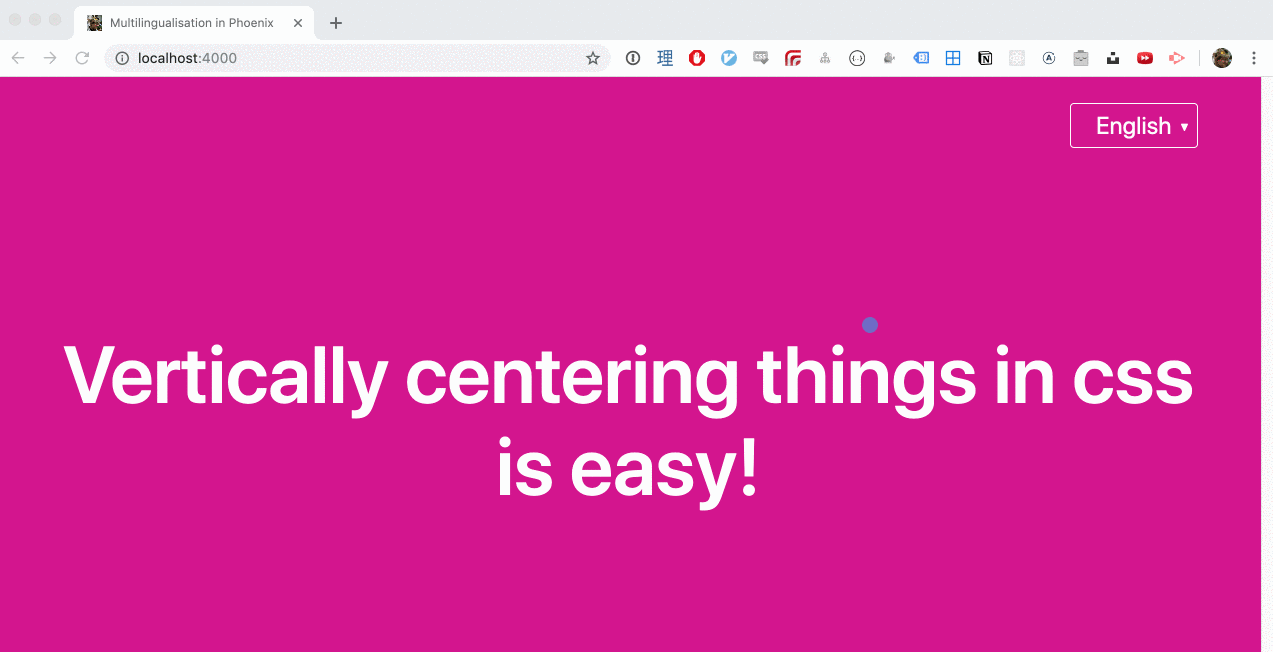
You can find the code for this iteration of the application in this post’s companion Github repo on the 01-client-server branch.
Client-Server Issues
So, we have language switching working, but what is wrong here?
- It takes time to open and close the menu, and to change locale, since we are doing a round trip to the server
- We cannot make the menu close if we click elsewhere on the page, since we cannot use Javascript
onclickhandlers. We also cannot make the entire<body>content a link, since we would have the dropdown links inside that body content link, and HTML does not do nested links.
Since we are missing a use case from the Elm implementation, let’s compromise and allow some Javascript “sprinkles” into the application.
Javascript Sprinkles
For this next step, aside from introducing some Javascript code, the main functionality of the application will not change very much.
Add Tag Metadata
We will need to allow Javascript to target certain page elements in order to manipulate them or perform some other actions, and that will take the form of adding some ids and roles to tags. So, let’s open up the following files and make those small changes:
lib/phx_i18n_example_web/templates/layout/app.html.eex
<!-- ... -->
<body class="<%= body() %>" id="body">
<!-- ... -->
</body>
<!-- ... -->
lib/phx_i18n_example_web/templates/language_dropdown/language_dropdown.html.eex
<!-- ... -->
<ul class="<%= dropdown_list(@show_available_locales) %>" id="locale_dropdown">
<!-- ... -->
</ul>
<!-- ... -->
lib/phx_i18n_example_web/templates/language_dropdown/_current_locale_link.eex
<a href="?show_available_locales=<%= !@show_available_locales %>"
class="<%= current_selection_link() %>"
id="current_locale_link">
<p class="<%= current_selection(@show_available_locales) %>" id="current_locale">
<!-- ... -->
</p>
</a>
lib/phx_i18n_example_web/templates/language_dropdown/_locale_link.eex
<a href="?locale=<%= @locale %>"
class="<%= dropdown_list_item_link() %>"
role="locale_link">
<!-- ... -->
</a>
Add Javascript
Now, in the main Javascript entry point for a Phoenix application, we are going to add a click-handler to the <body> that tells the dropdown to hide itself:
assets/js/app.js
// ...
// Import local files
//
// Local files can be imported directly using relative paths, for example:
// import socket from "./socket"
import { LocaleDropdown } from "./locale_dropdown"
document.getElementById("body").onclick = () => {
LocaleDropdown.hide()
}
I prefer Javascript with an interface that looks like it follows an Elixir-like Module.function() convention. This was able to be done using an Immediately Invoked Function Expression (IIFE; pronounced “iffy”) that returns an object containing functions in its values:
assets/js/locale_dropdown.js
export { LocaleDropdown }
const LocaleDropdown = ((document, window) => {
const LOCALE_DROPDOWN_CLASSES = document.getElementById("locale_dropdown").classList
const CURRENT_LOCALE_CLASSES = document.getElementById("current_locale").classList
const CURRENT_LOCALE_LINK = document.getElementById("current_locale_link")
const LOCALE_DROPDOWN_LINKS =
document.querySelectorAll('[role="locale_link"], #current_locale_link')
// REF: https://tachyons.io/docs/table-of-styles/
const TOP_BORDER_RADIUS_ONLY = "br--top"
const DROPDOWN_VISIBLE_CLASSES = ["flex", "flex-column"]
const DROPDOWN_HIDDEN_CLASS = "dn"
initLocaleDropdownLinks()
return Object.freeze({
hide: hide
})
function initLocaleDropdownLinks() {
LOCALE_DROPDOWN_LINKS.forEach(link => {
// NOTE: Prevent propagation to the onclick handler for the `body` tag.
link.onclick = event => { event.stopPropagation() }
})
}
function hide() {
if (isVisible()) {
hideLocaleDropdown()
setCurrentLocaleLinkToOpenDropdownMenu()
resetCurrentLocaleBottomBorderRadius()
updateShowAvailableLocalesToHidden()
}
}
function isVisible() {
return (
DROPDOWN_VISIBLE_CLASSES.some(value => {
return LOCALE_DROPDOWN_CLASSES.contains(value)
})
)
}
function hideLocaleDropdown() {
LOCALE_DROPDOWN_CLASSES.remove(...DROPDOWN_VISIBLE_CLASSES)
LOCALE_DROPDOWN_CLASSES.add(DROPDOWN_HIDDEN_CLASS)
}
function setCurrentLocaleLinkToOpenDropdownMenu() {
CURRENT_LOCALE_LINK.setAttribute("href", "/?show_available_locales=true")
}
function resetCurrentLocaleBottomBorderRadius() {
CURRENT_LOCALE_CLASSES.remove(TOP_BORDER_RADIUS_ONLY)
}
function updateShowAvailableLocalesToHidden() {
// NOTE: This is done purely from a UX standpoint: If the locale dropdown is
// closed, do not have the search parameter say that it's open.
if (window.location.search === "?show_available_locales=true") {
window.history.pushState(
{}, document.title, "/?show_available_locales=false"
)
}
}
})(document, window)
Yes, this is a pretty liberal helping of Javascript “sprinkles”, but, we needed it. We won’t go through all the details of this code, but there a few peculiarities worth bringing up briefly:
- As the IIFE executes, it “initialises” itself by calling
initLocaleDropdownLinks(). This sets up event handlers to make sure all links in the dropdown menu, including the current locale link, do not have events generated by their clicks inadvertently propagate down to<body>tag, causingLocaleDropdown.hide()to also be called - The returned frozen object contains what is essentially the “public interface” for the IIFE: the
hidefunction, which, as you can see, is called inapp.js - The
documentandwindowdo not technically need to be passed into the IIFE as arguments since they are globally available, but I think encapsulation is always a goal worth striving for. It is probably also better to have as many variables as possible resolve locally within the IIFE, rather than have to go out and get global variables every time you want to use them
Now, when you open the dropdown menu, and click anywhere else on the page, the menu closes.
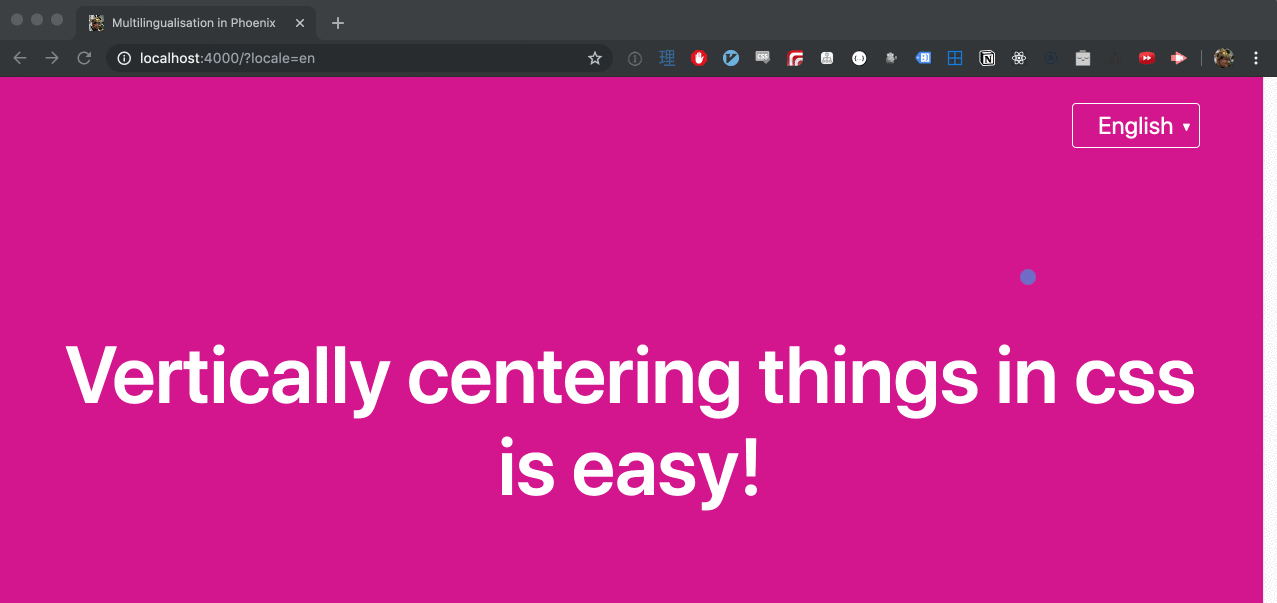
You can find the code for this iteration of the application in this post’s companion Github repo on the 02-js-sprinkles branch.
Javascript Sprinkles Issues
We are now technically on-par feature-wise with the Elm implementation, but there are still some lingering issues:
- It still takes time to open and close the menu and change the locale
- Closing the menu via clicking somewhere else on the page is snappier than clicking the current locale, even though their function is the same, which is a bit awkward
You can really feel now that we are perhaps unnecessarily forcing the back end to do things that the front end really wants us to do, so let’s acquiesce to Javascript and let it take over more functionality. Further, let’s get rid of any mandatory state management via URL parameters: like the Elm app, I don’t want to see parameters that I don’t have to.
Javascript Takeover
Remove Language Dropdown State Parameter
Dropdown state is currently managed via the @show_available_locales attribute, which is initially set in the LocalePlug, and then used throughout the templates and views. So, let’s first purge our plug of this param: open up locale_plug.ex, and delete the determine_language_dropdown_state/1 function entirely, since we are not determining the language dropdown state in the plug anymore. Then, remove that function call from the call/2 function as follows:
lib/phx_i18n_example_web/plugs/locale_plug.ex
defmodule PhxI18nExampleWeb.LocalePlug do
# ...
@impl Plug
def call(conn, _opts) do
locale = fetch_and_set_locale(conn)
persist_locale(conn, locale)
end
# ...
end
Great! Now, let’s go and remove any trace of the @show_available_locales in our templates and views. First, in the layout:
lib/phx_i18n_example_web/templates/layout/app.html.eex
<!-- ... -->
<%= render LanguageDropdownView, "language_dropdown.html" %>
<!-- ... -->
Then, in the dropdown menu template:
lib/phx_i18n_example_web/templates/language_dropdown/language_dropdown.html.eex
<div class="<%= dropdown_container() %>">
<%= render LanguageDropdownView, "_current_locale.html" %>
<ul class="<%= dropdown_list() %>" id="locale_dropdown">
<%= render_many selectable_locales(),
LanguageDropdownView,
"_locale_list_item.html",
as: :locale %>
</ul>
</div>
Here, you can see that we have renamed the _current_locale_link.html and _locale_link.html partials to _current_locale.html and _locale_list_item.html respectively, as we will use handlers for click events in them, rather than <a> links
The partials themselves look like the following:
lib/phx_i18n_example_web/templates/language_dropdown/_current_locale.html.eex
<p class="<%= current_selection() %>" id="current_locale">
<span><%= current_locale_string() %></span>
<span class="<%= caret() %>">▾</span>
</p>
lib/phx_i18n_example_web/templates/language_dropdown/_locale_list_item.html.eex
<li class="<%= dropdown_list_item() %>" id="<%= @locale %>" role="selectable_locale">
<%= locale_string(@locale) %>
</li>
The number of styling-related functions has also decreased as a result of these changes, so we change the view and styling module code accordingly:
lib/phx_i18n_example_web/views/language_dropdown_view.ex
defmodule PhxI18nExampleWeb.LanguageDropdownView do
# ...
defdelegate caret, to: LanguageDropdownStyle
defdelegate current_selection, to: LanguageDropdownStyle
defdelegate dropdown_container, to: LanguageDropdownStyle
defdelegate dropdown_list, to: LanguageDropdownStyle
defdelegate dropdown_list_item, to: LanguageDropdownStyle
# ...
end
lib/phx_i18n_example_web/views/styles/language_dropdown_style.ex
defmodule PhxI18nExampleWeb.LanguageDropdownStyle do
@caret_classes ~w[
absolute
ml2
] |> Enum.join(" ")
@current_selection_classes ~w[
b--white
ba
br2
pa2
pointer
tc
w4
] |> Enum.join(" ")
@dropdown_container_classes ~w[
center
f3
flex
h3
items-center
justify-end
w-90
] |> Enum.join(" ")
# NOTE: Default visibility is `display: none` (`dn`).
@dropdown_list_classes ~w[
absolute
b--white
bb
bl
br
br--bottom
br2
dn
items-center
list
mt5
pl0
pointer
pr0
pt1
tc
top-0
w4
] |> Enum.join(" ")
@dropdown_list_item_classes ~w[
hover-bg-white
hover-dark-pink
ph1
pv2
pt0
w-100
] |> Enum.join(" ")
def caret, do: @caret_classes
def current_selection, do: @current_selection_classes
def dropdown_container, do: @dropdown_container_classes
def dropdown_list, do: @dropdown_list_classes
def dropdown_list_item, do: @dropdown_list_item_classes
end
Increase Javascript Responsibility
Finally, we update the locale dropdown Javascript so that it can:
- Open the dropdown, as well as close it
- Handle click events for each locale in the dropdown list, including the current locale
- Prompt a locale change by sending an AJAX request, and then update the page with the server response
assets/js/locale_dropdown.js
export { LocaleDropdown }
const LocaleDropdown = ((document, window) => {
const LOCALE_DROPDOWN_CLASSES = document.getElementById("locale_dropdown").classList
const CURRENT_LOCALE = document.getElementById("current_locale")
const SELECTABLE_LOCALES = document.querySelectorAll("[role='selectable_locale']")
// REF: https://tachyons.io/docs/table-of-styles/
const TOP_BORDER_RADIUS_ONLY = "br--top"
const DROPDOWN_VISIBLE_CLASSES = ["flex", "flex-column"]
const DROPDOWN_HIDDEN_CLASS = "dn"
initCurrentLocale()
initSelectableLocales()
return Object.freeze({
hide: hide
})
function initCurrentLocale() {
const currentLocaleClassList = CURRENT_LOCALE.classList
CURRENT_LOCALE.onclick = event => {
// NOTE: Prevent propagation to the onclick handler for the `body` tag.
event.stopPropagation()
if (isVisible()) {
hideLocaleDropdown()
removeCurrentLocaleBottomBorderRadius(currentLocaleClassList)
} else {
showLocaleDropdown()
addCurrentLocaleBottomBorderRadius(currentLocaleClassList)
}
}
}
function initSelectableLocales() {
SELECTABLE_LOCALES.forEach(locale => {
locale.onclick = () => {
changeLocale(locale)
}
})
}
function hide() {
const currentLocaleClassList = CURRENT_LOCALE.classList
if (isVisible()) {
hideLocaleDropdown()
removeCurrentLocaleBottomBorderRadius(currentLocaleClassList)
}
}
function changeLocale(locale) {
// Clear params in case the locale was originally set using them.
window.history.replaceState({}, document.title, "/")
const xhr = new XMLHttpRequest()
xhr.open("GET", document.location.origin + `?locale=${locale.id}`)
xhr.onreadystatechange = () => {
document.open()
document.write(xhr.responseText)
document.close()
}
xhr.send()
}
function isVisible() {
return (
DROPDOWN_VISIBLE_CLASSES.some(value => {
return LOCALE_DROPDOWN_CLASSES.contains(value)
})
)
}
function hideLocaleDropdown() {
LOCALE_DROPDOWN_CLASSES.remove(...DROPDOWN_VISIBLE_CLASSES)
LOCALE_DROPDOWN_CLASSES.add(DROPDOWN_HIDDEN_CLASS)
}
function showLocaleDropdown() {
LOCALE_DROPDOWN_CLASSES.add(...DROPDOWN_VISIBLE_CLASSES)
LOCALE_DROPDOWN_CLASSES.remove(DROPDOWN_HIDDEN_CLASS)
}
function removeCurrentLocaleBottomBorderRadius(currentLocaleClassList) {
currentLocaleClassList.remove(TOP_BORDER_RADIUS_ONLY)
}
function addCurrentLocaleBottomBorderRadius(currentLocaleClassList) {
currentLocaleClassList.add(TOP_BORDER_RADIUS_ONLY)
}
})(document, window)
After applying those changes, you can see that the application is now as snappy as the Elm version.
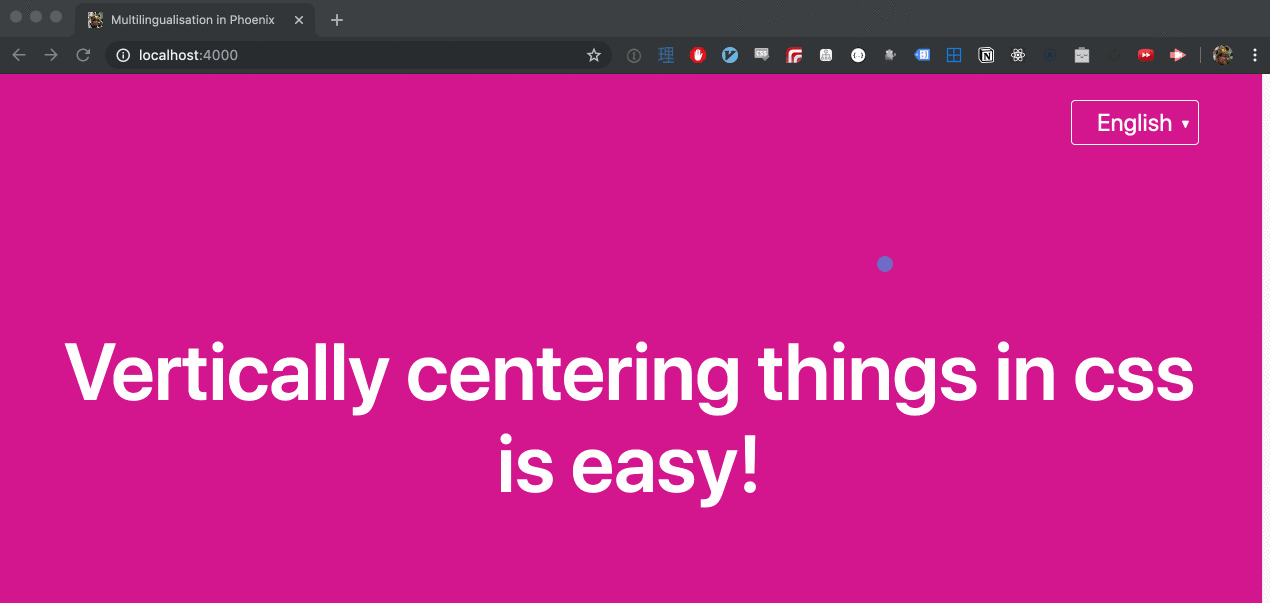
You can find the code for this iteration of the application in this post’s companion Github repo on the 03-js-takeover branch.
Javascript Takeover Issues
In order to fetch translations, the application is still making a call out to the server, so it will never be quite as fast as Elm there, but that’s fine: I would rather not give up using the gettext API for a potential front-end-based solution.
But, the issue now is…we have a lot of Javascript ![]() ! Wouldn’t it be nicer if we could handle all this “front-end” functionality in Elixir-land? Well, let’s see how much LiveView can help us in achieving that goal!
! Wouldn’t it be nicer if we could handle all this “front-end” functionality in Elixir-land? Well, let’s see how much LiveView can help us in achieving that goal!
LiveView
It feels like it’s been a long evolution for this application, but we are finally at the main event: leveraging the power of LiveView!
Before we begin changing our application logic, we have some new dependencies to add and some configuration ceremony to perform, so let’s do that.
Installation and Configuration
NOTE: The method of installation/configuration below is current as of LiveView 0.3.1, but since LiveView is a rapidly evolving project as of this writing, make sure to check the Phoenix LiveView README file for the latest information if you run into any issues.
First, we need to install the LiveView hex package, so add the following entries to your mix file:
mix.exs
defmodule PhxI18nExample.MixProject do
# ...
defp deps do
[
# ...
{:phoenix_live_view, "~> 0.3.0"},
{:floki, ">= 0.0.0", only: :test}
]
end
Then, run mix deps.get.
Next, we need to add configuration for a signing salt. Generate one by running mix phx.gen.secret 32, and then add it as follows:
config/config.exs
config :phx_i18n_example, PhxI18nExampleWeb.Endpoint,
# ...
live_view: [
signing_salt: "<YOUR_SECRET_SALT>"
]
Add the LiveView flash to the browser pipeline:
lib/phx_i18n_example_web/router.ex
defmodule PhxI18nExampleWeb.Router do
# ...
pipeline :browser do
# ...
plug :fetch_flash
plug Phoenix.LiveView.Flash
# ...
end
# ...
end
Add some LiveView configuration to your controllers, views, and router in your web file:
lib/phx_i18n_example_web.ex
defmodule PhxI18nExampleWeb do
# ...
def controller do
quote do
# ...
import Phoenix.LiveView.Controller
end
end
def view do
quote do
# ...
import Phoenix.LiveView,
only: [
live_render: 2,
live_render: 3,
live_link: 1,
live_link: 2
]
end
end
def router do
quote do
# ...
import Phoenix.LiveView.Router
end
end
# ...
end
Expose a new websocket for LiveView updates:
lib/phx_i18n_example_web/endpoint.ex
defmodule PhxI18nExampleWeb.Endpoint do
use Phoenix.Endpoint, otp_app: :phx_i18n_example
socket "/live", Phoenix.LiveView.Socket
# ...
end
Add LiveView to the Node dependencies:
assets/package.json
{
// ...
"dependencies": {
// ...
"phoenix_live_view": "file:../deps/phoenix_live_view"
},
// ...
}
Install the dependencies with:
npm install --prefix assets
Finally, enable connecting to a LiveView socket from Javascript:
assets/js/app.js
// ...
import { Socket } from "phoenix"
import LiveSocket from "phoenix_live_view"
let liveSocket = new LiveSocket("/live", Socket)
liveSocket.connect()
Okay, configuration ceremony complete! Now, let’s move over to actually changing the application.
From Conn to Session
We will start, yet again, with the locale plug, where we find that there are some significant changes from before:
lib/phx_i18n_example_web/plugs/locale_plug.ex
defmodule PhxI18nExampleWeb.LocalePlug do
alias Plug.Conn
@behaviour Plug
@locales Gettext.known_locales(PhxI18nExampleWeb.Gettext)
@cookie "phxi18nexamplelanguage"
defguard known_locale?(locale) when locale in @locales
@impl Plug
def init(_opts), do: nil
@impl Plug
def call(conn, _opts) do
locale = fetch_locale(conn)
conn
|> Conn.assign(:locale, locale)
|> Conn.put_session(:locale, locale)
end
defp fetch_locale(conn) do
case locale_from_params(conn) || locale_from_cookies(conn) do
nil ->
# NOTE: This will fallback to the default locale set in `config.exs`
Gettext.get_locale()
locale ->
locale
end
end
defp locale_from_params(%Conn{params: %{"locale" => locale}})
when known_locale?(locale) do
locale
end
defp locale_from_params(_conn), do: nil
defp locale_from_cookies(%Conn{cookies: %{@cookie => locale}})
when known_locale?(locale) do
locale
end
defp locale_from_cookies(_conn), do: nil
end
A few notes on this file:
- In the
fetch_locale/1function, we are still attempting to fetch the locale from values potentially given in the params, or in the cookies. If we cannot find it, we ask gettext to give us the default locale; that part has not changed. However, if we do find the locale, we are simply returning it, without callingGettext.put_locale/1to set the locale globally, because LiveViews run in their own process. As opposed to before, where the application was essentially single process, the application will now be multi-process, which means that there is no global locale for a LiveView to refer to, even if we do set it: each process can only rely on its own encapsulated state, and hence will need a local reference to a locale - This relates directly to why we are using
Plug.Conn.put_session/3: we providesessiondata to LiveViews, notconndata, to initialise their state - We are also providing the exact same locale data to the
connassigns, though. Why store the same data in two different places? Because the layout template the LiveView is rendered in,app.html.eex, needs it. A layout, or at least the main layout (I have not tested nested layouts), as far as I can gather, can have LiveViews rendered within in it, but cannot itself be a LiveView (this took me far too long to finally figure out) - All code related to persisting the locale value in the cookie has been removed since a
Phoenix.LiveView.Socketdoes not have the ability to directly access or assign values to cookies. So how do we make sure the application can remember our locale choice? Using a Javascript escape hatch called “hooks” to get at the cookies, which we will see more of later…
Goodbye Controller, Hello LiveView
Now, let’s see about getting a LiveView rendered. First, to the router:
lib/phx_i18n_example_web/router.ex
defmodule PhxI18nExampleWeb.Router do
# ...
scope "/", PhxI18nExampleWeb do
pipe_through :browser
live "/", PageLive, session: [:locale]
end
end
- Rather than routing the root path to the
PageController, we can route directly to a LiveView withPhoenix.LiveView.Router.live/3. LiveViews are responsible for setting up state within their own process, so they pretty much fulfil the role that a controller would. So, if you would like, you can safely delete thelib/phx_i18n_example_web/controllers/page_controller.exfile. (Note that we could have continued to usePageController, and just converted theindexfunction’srender/3to alive_render/3, but it’s purpose would have only been to manually extract thelocaleout ofconn.assignsand assign it to thesession, so I figured going straight to aliveroute would feel more “LiveView-y”, if that’s even a thing…) - The
session: [:locale]option here indicates that we want to pass the sessionlocalevalue we populated in theLocalePlugtoPageLive, our named LiveView
Speaking of which, let’s create a PageLive module, which, by what seems like an emerging convention, should be placed in a live/ web directory:
lib/phx_i18n_example_web/live/page_live.ex
defmodule PhxI18nExampleWeb.PageLive do
use Phoenix.LiveView
alias PhxI18nExampleWeb.PageView
def mount(%{locale: locale}, socket) do
socket = assign(socket, locale: locale)
{:ok, socket}
end
def render(assigns) do
PageView.render("index.html", assigns)
end
end
A LiveView has two main callback functions that you must implement:
-
mount/2, where you set up your initial state from session values and assign them to thesocketstate -
render/1, which is responsible for returning rendered content, which in this case is theindex.htmltemplate, passing it theassignsinformation, which comes from thesocket. So, in this case,assignscould contain%{locale: "en"}if that is what was set in the socket, either frommount/2, or an event handler, which we will look at later
As for the index.html template that gets rendered in the LiveView, it looks fairly similar to before, but we now need to give it a .leex extension for Live Embedded Elixir:
lib/phx_i18n_example_web/templates/page/index.html.leex
<%= with_locale(@locale, fn -> %>
<article class="<%= article() %>" phx-click="hide-dropdown">
<div class="<%= heading_container() %>">
<h1 class="<%= heading() %>">
<%= gettext("Vertically centering things in css is easy!") %>
</h1>
</div>
</article>
<% end) %>
- As mentioned previously, we can no longer rely on
Gettext.get_locale/0to be our global source of truth for the application locale, since each LiveView is its own process. So, we need to specifically provide a locale to every template that needs translating. I initially thought that I could useGettext.get_locale/0andGettext.put_locale/1within a LiveView to set a global locale within the LiveView process: I tried using them inmount/2,render/1, and even within the above template, but I had no luck in getting the string-to-translate to re-evaluate until I usedGettext.with_locale/2with the@localethat was set in thesocket.assigns. So, please be aware of that potentially time-consuming gotcha, or, if you found a way to use them in LiveView, please let me know! - The
<article>tag now has aphx-click="hide-dropdown"binding on it, which will sendPageLivea"hide-dropdown"message when it is clicked (remember that clicking outside the dropdown menu while it is open should close the menu). We haven’t put the message-handling code inPageLivejust yet, but we will come back to it
In order to get with_locale/2 available in the template, make sure to update the PageView:
lib/phx_i18n_example_web/views/page_view.ex
defmodule PhxI18nExampleWeb.PageView do
use PhxI18nExampleWeb, :view
import Gettext, only: [with_locale: 2]
# ...
end
Every LiveView in its own Process
In the layout, the standard <%= render @view_module, @view_template, assigns %> statement renders the PageLive LiveView, but that is not the only place where we need dynamic functionality. The language dropdown needs to open, close, and change locale, and the page title needs to change when the locale changes.
We cannot wrap the entire page in a single LiveView (there’s no equivalent for document.getElementById("body").onclick for us here), so we are going to need separate LiveViews for the dropdown menu and title, rendered from the layout:
lib/phx_i18n_example_web/templates/layout/app.html.eex
<!DOCTYPE html>
<html>
<head>
<!-- ... -->
<%= live_render @conn, TitleLive, session: %{locale: @locale} %>
</head>
<body class="<%= body() %>">
<%= live_render @conn, LanguageDropdownLive, session: %{locale: @locale} %>
<main role="main">
<%= render @view_module, @view_template, assigns %>
</main>
<!-- ... -->
</body>
</html>
The live_render/3 function “renders a LiveView within an originating plug request or within a parent LiveView”. If we were rendering these LiveViews from another LiveView, we would pass in the parent LiveView’s @session attribute. But, since the layout is within a plug request, we do not have a session yet, and, therefore, need to create one for the new LiveViews. Hence, we use @conn as the first argument, and make sure to pass in the @locale attribute from the conn, that we set up in the LocalePlug (remember, we set the same locale value in both the conn and in the session), into both the TitleLive and LanguageDropdownLive’s session.
In order to have TitleLive aliased properly in the layout template, make sure to make the following minor change to the LayoutView:
lib/phx_i18n_example_web/views/layout_view.ex
# ...
alias PhxI18nExampleWeb.{LanguageDropdownLive, LayoutStyle, TitleLive}
We will get into the details of TitleLive and LanguageDropdownLive soon, but an important thing to understand is that we now have 3 LiveViews, each running in their own separate process, which conceptually looks like this:
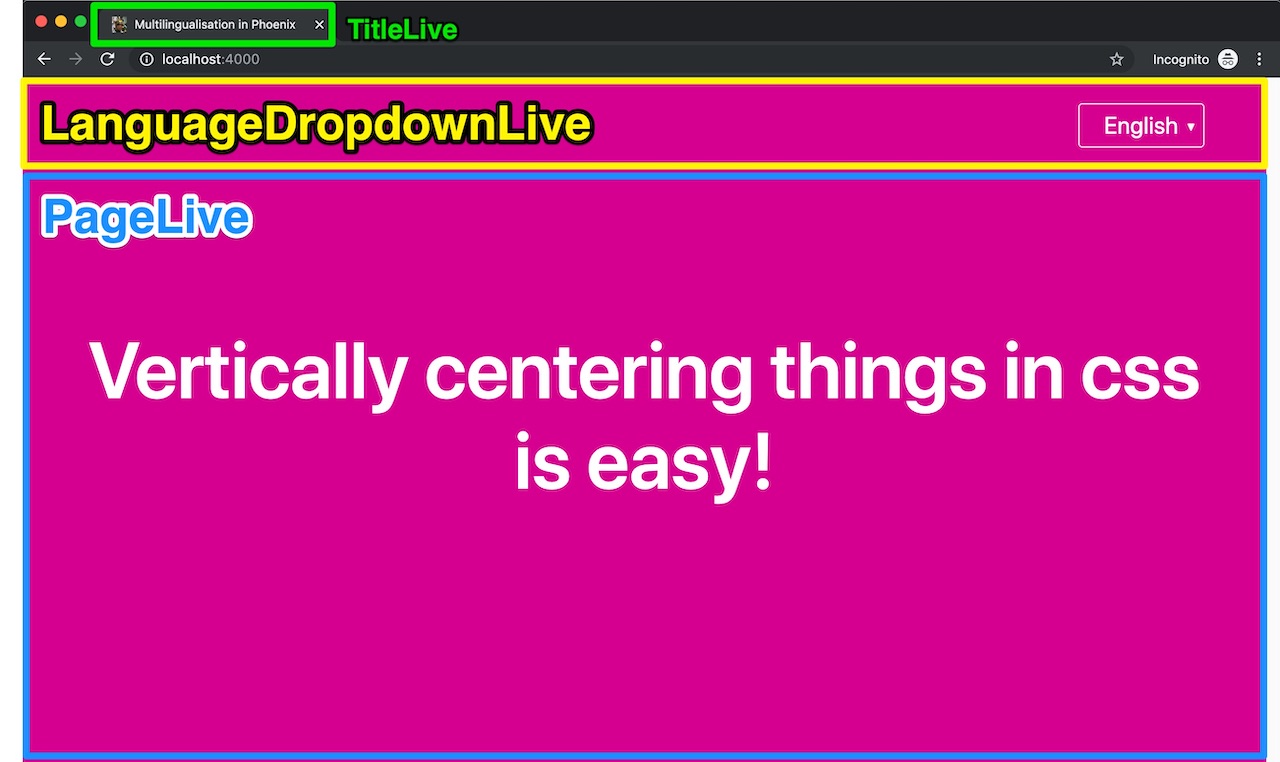
Now, even though each of these LiveViews exist in isolated processes, they still need to be able to talk to each other when certain events occur:
- When
LocaleDropdownLivechanges the locale,PageLiveandTitleLiveneed to know what the locale has been changed to so they can re-render themselves with the correct string for the locale - When the current locale is clicked, it needs to look at what the state of the available locales dropdown menu is, open or closed, and toggle it
- If the dropdown menu is open in
LocaleDropdownLive, and a click occurs either inPageLiveor inLocaleDropdownLiveoutside of the dropdown menu,LocaleDropdownLiveneeds to know so that it can re-render itself with a closed menu
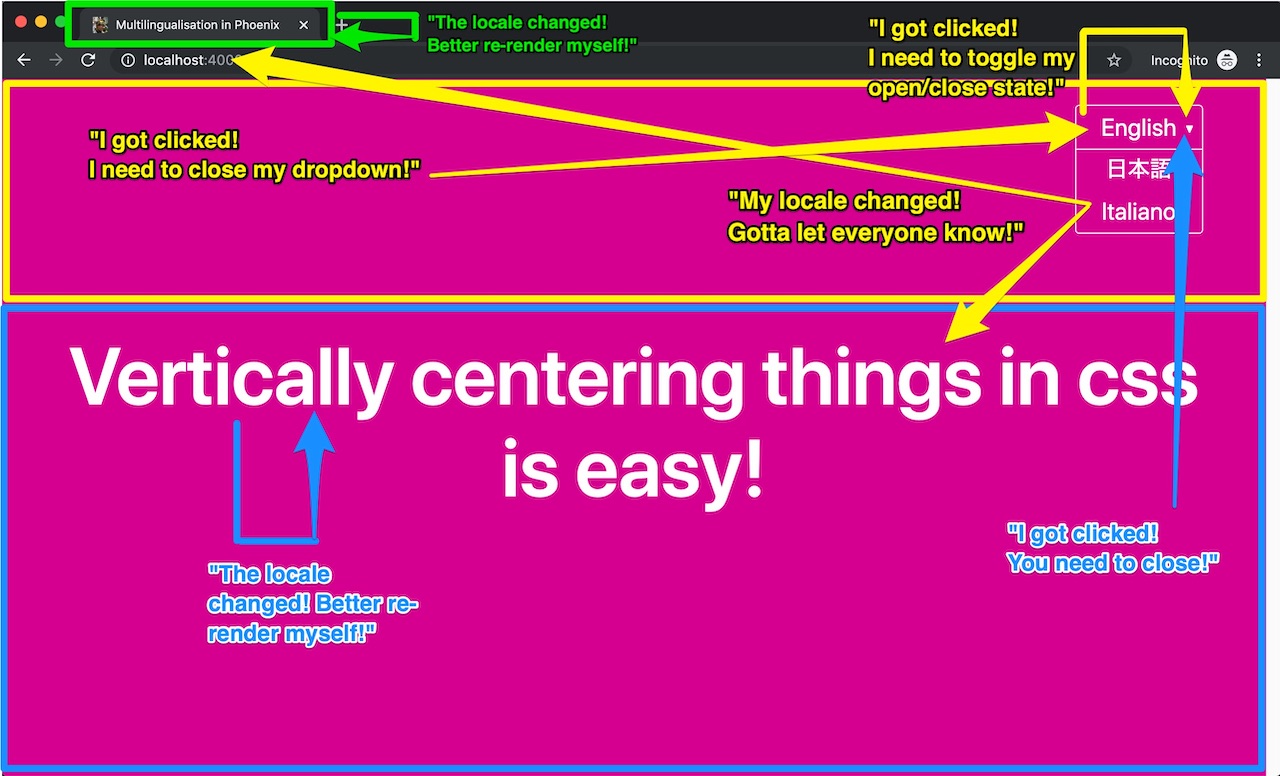
In order to get these LiveViews chatting, we will call on Phoenix PubSub to help us out.
LiveView Event Handling
Since we’re already most familiar with PageLive, let’s code up message handling there first:
lib/phx_i18n_example_web/live/page_live.ex
defmodule PhxI18nExampleWeb.PageLive do
use Phoenix.LiveView
alias PhxI18nExampleWeb.{Endpoint, PageView}
@locale_changes "locale-changes"
@dropdown_changes "dropdown-changes"
def mount(%{locale: locale}, socket) do
Endpoint.subscribe(@locale_changes)
socket = assign(socket, locale: locale)
{:ok, socket}
end
def render(assigns) do
PageView.render("index.html", assigns)
end
def handle_event("hide-dropdown", _value, socket) do
Endpoint.broadcast_from(self(), @dropdown_changes, "hide-dropdown", %{})
{:noreply, socket}
end
def handle_info(%{event: "change-locale", payload: %{locale: locale}}, socket) do
socket = assign(socket, :locale, locale)
{:noreply, socket}
end
end
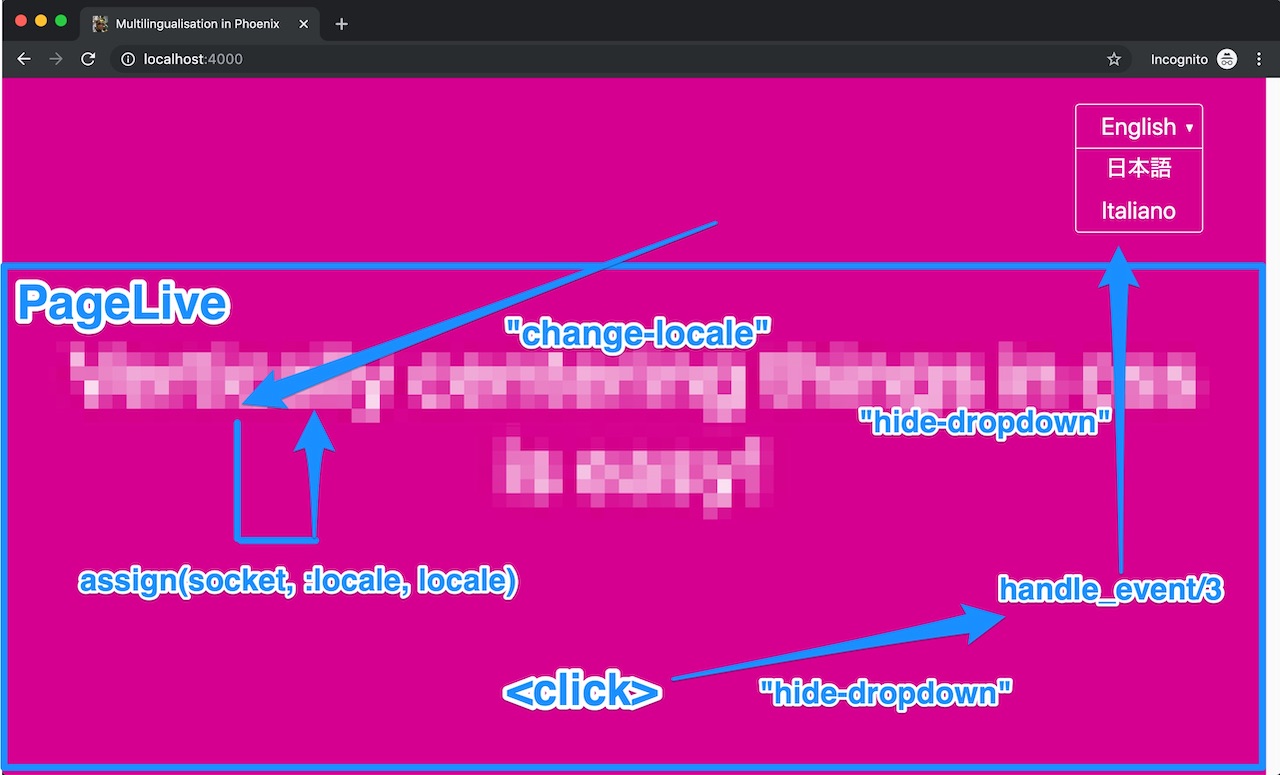
- There are two different types of messages that
PageViewhas to concern itself with: locale change messages, and dropdown change messages, which we have set up as two different Phoenix Channel names:@locale_changesand@dropdown_changes. Not all LiveViews will need to care about all kinds of messages, which is why we are not using a single channel for all message types - When the
PageViewmounts, it callsPhoenix.Endpoint.subscribe/2to set up a subscription to@locale_changesmessages, since it needs to be told when the locale changes so it can render the correct language string. The message we are looking out for from@locale_changesis called"change-locale", which we handle withPhoenix.LiveView.handle_info/2. When we get the"change-locale"message, we extract thelocalefrom itspayload, and assign it to thesocket.render/1will then be called automatically, and any necessary template re-rendering will occur - The
PageViewalso needs to listen out for"hide-dropdown"messages that its own template,index.html.leexcould send to it (remember we setphx-click="hide-dropdown"on the<article>tag). When a"hide-dropdown"message is received byPhoenix.LiveView.handle_event/3, thePageViewdoes not need to do anything to itself, but it instead callsPhoenix.Endpoint.broadcast_from/4to send out a broadcast to anything that’s listening on the@dropdown_changeschannel telling it that they should hide their dropdown; you can probably guess what would be listening out for that
Let’s now create a TitleLive module:
lib/phx_i18n_example_web/live/title_live.ex
defmodule PhxI18nExampleWeb.TitleLive do
use Phoenix.LiveView
import PhxI18nExampleWeb.Gettext, only: [gettext: 1]
import Gettext, only: [with_locale: 2]
alias PhxI18nExampleWeb.Endpoint
@locale_changes "locale-changes"
def mount(%{locale: locale}, socket) do
Endpoint.subscribe(@locale_changes)
socket = assign(socket, locale: locale)
{:ok, socket}
end
def render(assigns) do
~L"""
<%= with_locale(@locale, fn -> %>
<title>
<%= gettext("Multilingualisation in Phoenix") %>
</title>
<% end) %>
"""
end
def handle_info(%{event: "change-locale", payload: %{locale: locale}}, socket) do
socket = assign(socket, :locale, locale)
{:noreply, socket}
end
end
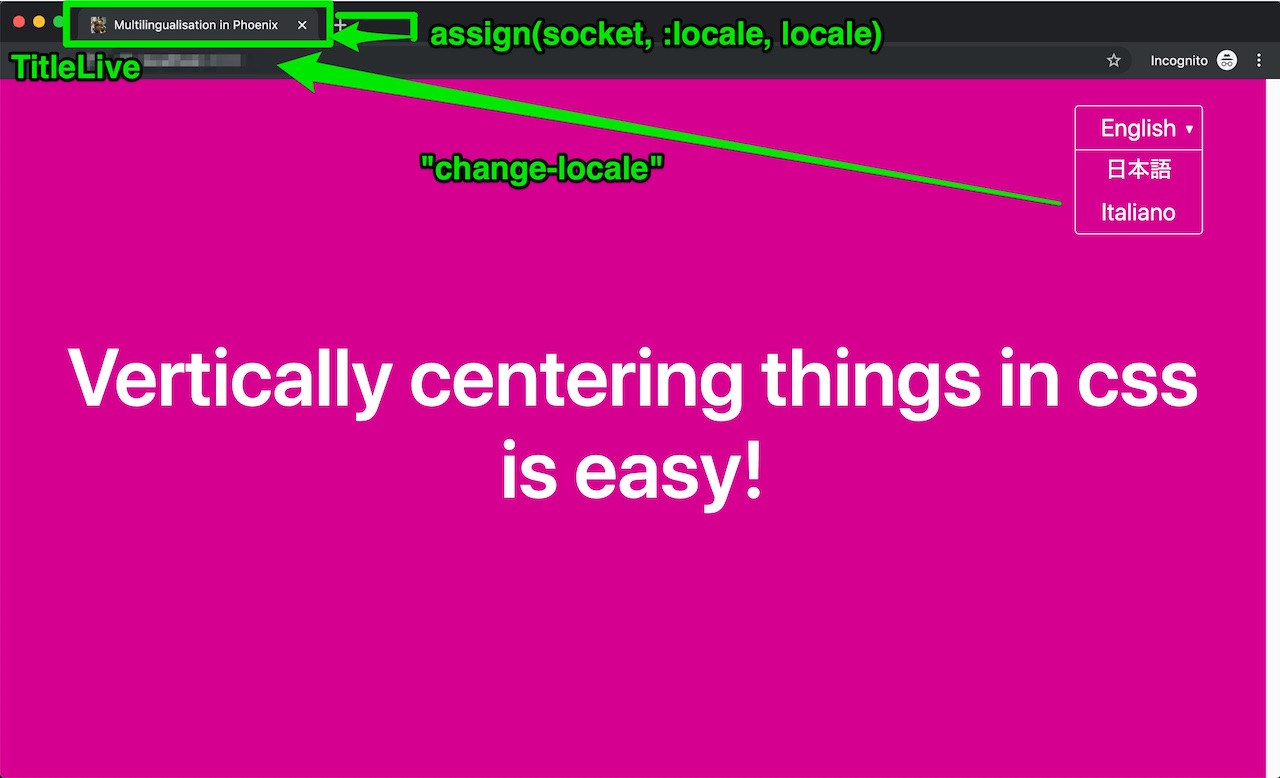
- As you can see, the
mount/1andhandle_info/2functions are identical toPageView: they both subscribe to the@locale_changeschannel and specifically handle"change-locale"messages to change their own locales - For
render/1, though, because there is not much code, we will render it inline rather than create a new template just for the<title>tag - When I initially wrote the inline template, I figured that I could get away with leaving the
<title>tag inapp.html.eex, and just render thegettextmacro, since that’s the only thing that changes. However, a LiveView must contain at least one HTML tag in order to render, so just be aware of that gotcha
Let’s now create our last, and busiest, LiveView: LanguageDropdownLive.
lib/phx_i18n_example_web/live/language_dropdown_live.ex
defmodule PhxI18nExampleWeb.LanguageDropdownLive do
use Phoenix.LiveView
alias PhxI18nExampleWeb.{Endpoint, LanguageDropdownView}
@locales Gettext.known_locales(PhxI18nExampleWeb.Gettext)
@locale_changes "locale-changes"
@dropdown_changes "dropdown-changes"
def mount(%{locale: locale}, socket) do
Endpoint.subscribe(@dropdown_changes)
socket = init_dropdown_state(socket, locale)
{:ok, socket}
end
def render(assigns) do
LanguageDropdownView.render("language_dropdown.html", assigns)
end
# Event handling code will go here...
defp init_dropdown_state(socket, locale) do
selectable_locales = List.delete(@locales, locale)
assign(
socket,
%{
locale: locale,
selectable_locales: selectable_locales,
show_available_locales: false
}
)
end
end
For the time-being, we will leave out any event handling code, and instead gradually add it in as we look through the templates that will fire off the events that LanguageDropdownLive needs to handle. The major points we need to know about at this stage are:
-
LanguageDropdownLivesubscribes to the@dropdown_changeschannel, since clicks could occur within itself, outside of the actual dropdown menu, as well as fromPageLive, that would necessitate it to close the dropdown menu - We have also set up a
@locale_changeschannel, that we will broadcast on to letPageLiveandTitleLiveknow about locale changes, and which we will use in an event handler soon - On
mount, theinit_dropdown_state/2function is called to…initialise the dropdown state. Note that we have brought back theshow_available_localesattribute that we initially got rid of when we migrated from client-server to Javascript. It is now back to being a part of the overall language dropdown state, and so we need to deal with it here in the LiveView
A Quick Styling Detour
The re-emergence of show_available_locales affects the way we deal with the Tachyons styling, so we will make a quick detour to handle re-writing of the LanguageDropdownView and LanguageDropdownStyle files to re-incorporate the show_available_locales attribute:
lib/phx_i18n_example_web/views/language_dropdown_view.ex
defmodule PhxI18nExampleWeb.LanguageDropdownView do
use PhxI18nExampleWeb, :view
alias PhxI18nExampleWeb.LanguageDropdownStyle
alias __MODULE__, as: LanguageDropdownView
@locale_strings %{
"en" => "English",
"it" => "Italiano",
"ja" => "日本語"
}
defdelegate caret, to: LanguageDropdownStyle
defdelegate current_selection(show_available_locales), to: LanguageDropdownStyle
defdelegate dropdown_container, to: LanguageDropdownStyle
defdelegate dropdown_list(show_available_locales), to: LanguageDropdownStyle
defdelegate dropdown_list_item, to: LanguageDropdownStyle
def locale_string(locale), do: @locale_strings[locale]
end
lib/phx_i18n_example_web/views/styles/language_dropdown_style.ex
defmodule PhxI18nExampleWeb.LanguageDropdownStyle do
@caret_classes ~w[
absolute
ml2
] |> Enum.join(" ")
@current_selection_classes ~w[
b--white
ba
br2
pa2
pointer
tc
w4
]
@current_selection_border_radius_classes "br--top"
@current_selection_link_classes ~w[
no-underline
white
] |> Enum.join(" ")
@dropdown_container_classes ~w[
center
f3
flex
h3
items-center
justify-end
w-90
] |> Enum.join(" ")
@dropdown_list_classes ~w[
absolute
b--white
bb
bl
br
br--bottom
br2
items-center
list
mt5
pl0
pointer
pr0
pt1
tc
top-0
w4
]
@dropdown_show_classes ~w[
flex
flex-column
] |> Enum.join(" ")
@dropdown_hide_classes "dn"
@dropdown_list_item_classes ~w[
hover-bg-white
hover-dark-pink
ph1
pv2
pt0
w-100
] |> Enum.join(" ")
@dropdown_list_item_link_classes ~w[
no-underline
w-100
white
] |> Enum.join(" ")
def caret, do: @caret_classes
def current_selection(show_available_locales) do
display_classes =
if show_available_locales do
[@current_selection_border_radius_classes | @current_selection_classes]
else
@current_selection_classes
end
Enum.join(display_classes, " ")
end
def current_selection_link, do: @current_selection_link_classes
def dropdown_container, do: @dropdown_container_classes
def dropdown_list(show_available_locales) do
display_classes =
if show_available_locales do
[@dropdown_show_classes | @dropdown_list_classes]
else
[@dropdown_hide_classes | @dropdown_list_classes]
end
Enum.join(display_classes, " ")
end
def dropdown_list_item, do: @dropdown_list_item_classes
def dropdown_list_item_link, do: @dropdown_list_item_link_classes
end
Language Dropdown Event Handling
Back to our scheduled event handling programming. Let’s dive straight into the language dropdown template:
lib/phx_i18n_example_web/templates/language_dropdown/language_dropdown.html.leex
<div class="<%= dropdown_container() %>" phx-click="hide">
<%= render LanguageDropdownView,
"_current_locale.html",
locale: @locale,
show_available_locales: @show_available_locales %>
<ul class="<%= dropdown_list(@show_available_locales) %>">
<%= render_many @selectable_locales,
LanguageDropdownView,
"_locale_list_item.html",
as: :locale %>
</ul>
</div>
- As expected, the language dropdown template is now a
.leexfile since it is being rendered by a LiveView - The full set of dropdown state that was set in the
socketis on display here, with the@localeand@show_available_localesattributes now being passed into the_current_locale.htmlpartial, and@selectable_localesnow being used to determine what locales need to have_locale_list_items.htmlpartials rendered for them, rather than aselectable_locales/0view function that we used previously - Notice that the partials are being
render-ed “normally”, as in, they are not beinglive_rendered. This is because the partials are not meant to be run in a separate process to the parent template and they are essentially “a part” of the parent template itself, and hence are automatically “live rendered”. Nested LiveViews are possible, but that is not what is occurring in this case
We can see the first event that LanguageDropdownLive needs to handle is a "hide" event, occurring whenever somewhere in the template that is not the dropdown menu is clicked, so let’s write the function to handle that:
lib/phx_i18n_example_web/live/language_dropdown_live.ex
defmodule PhxI18nExampleWeb.LanguageDropdownLive do
# ...
def handle_event("hide", _value, socket) do
socket = assign(socket, :show_available_locales, false)
{:noreply, socket}
end
# ...
end
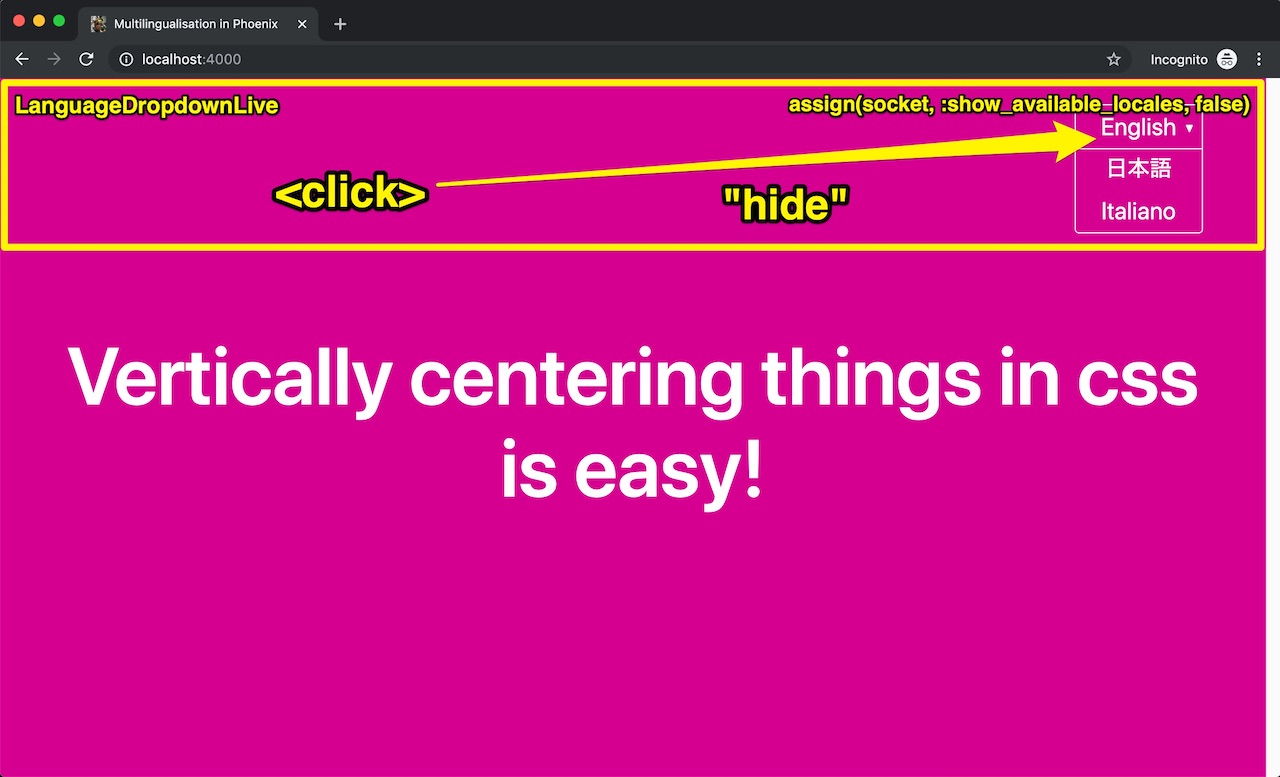
Okay, first event handled! Let’s now see what the _current_locale.html needs us to do:
lib/phx_i18n_example_web/templates/language_dropdown/_current_locale.html.eex
<p class="<%= current_selection(@show_available_locales) %>"
name="current_locale"
id="<%= @locale %>"
phx-click="toggle"
phx-hook="currentLocale">
<span><%= locale_string(@locale) %></span>
<span class="<%= caret() %>">▾</span>
</p>
Compared to before, the <p> tag now:
- has an
idattribute containing the@localepassed into it from its parent template - fires a
"toggle"message when clicked - has a binding to a hook named
"currentLocale"
Let’s handle the message first, and then the hook.
lib/phx_i18n_example_web/live/language_dropdown_live.ex
defmodule PhxI18nExampleWeb.LanguageDropdownLive do
# ...
def handle_event("toggle", _value, socket) do
%{assigns: %{show_available_locales: show_available_locales}} = socket
socket = assign(socket, :show_available_locales, !show_available_locales)
{:noreply, socket}
end
# ...
end
To handle the "toggle" message, we take the current value of the show_available_locales attribute from the socket, flip the value, and then re-assign it back to the socket.
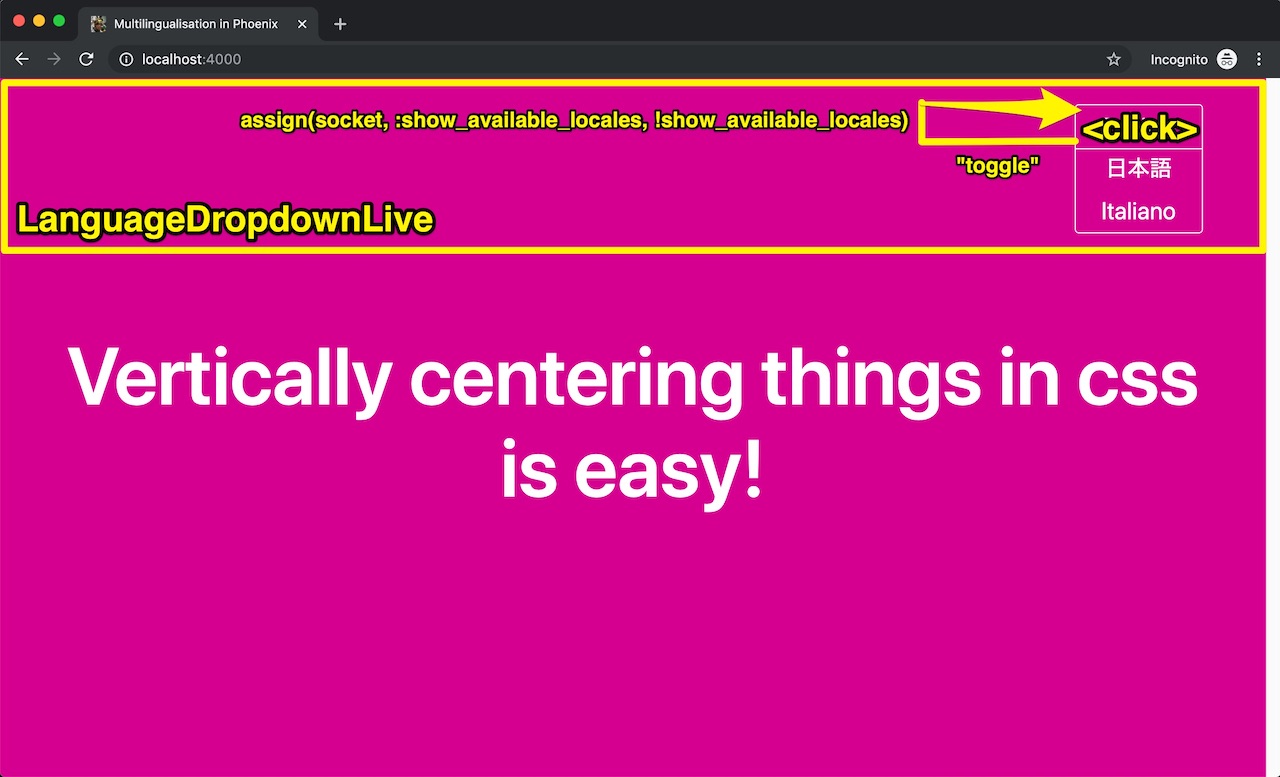
Hooks
LiveView provides life-cycle callback functions to handle custom client-side Javascript when an element is added, updated, or removed by the server. In our case, we are going to want to use two of those callback functions, mounted and updated, for the exact same purpose:
assets/js/app.js
// ...
import { Socket } from "phoenix"
import LiveSocket from "phoenix_live_view"
import { Cookie } from "./cookie"
const Hooks = {
currentLocale: {
mounted() {
Cookie.set(this.el.id)
// Clear params in case the locale was originally set using them.
window.history.replaceState({}, document.title, "/")
},
updated() {
Cookie.set(this.el.id)
}
}
}
let liveSocket = new LiveSocket("/live", Socket, { hooks: Hooks })
liveSocket.connect()
- In the
mounted()callback, executed when the current locale has been mounted into the DOM (eg when first opening the application or after a page refresh), we are able to access the<p>tag element from_current_locale.html.eexitself in by callingthis.el. Since we set anidattribute on the<p>tag containing the current locale, we can access it usingthis.el.id. - Since we have not explicitly disallowed setting the locale by params, but we do not want them to hang around after mounting, we clear them out using
History.replaceState - Since we want to make sure that the locale is stored in cookies on every locale change, which could happen during a mount (application first starts), and an update (locale is selected from the dropdown menu), we set the cookie in the
updated()callback as well - Make sure you pass a
{ hooks: Hooks }options object toLiveSocketin order to initialise the hooks
The Javascript to set the cookie looks like the following:
assets/js/cookie.js
export { Cookie }
const Cookie = (document => {
const NAME = "phxi18nexamplelanguage"
return { set: set }
function set(locale) {
document.cookie = `${NAME}=${locale}; expires=${expires()}`
}
function expires() {
let expiry = new Date()
// Set expiry to ten days
expiry.setDate(expiry.getDate() + 10)
return expiry.toGMTString()
}
})(document)
For some reason, it took me longer than expected to get the Document.cookie code working properly. Setting the cookie did not seem to work unless its name only contained letters and numbers, and no other characters. Maybe you will have better luck if you decide to re-write any of this code.
Passing Values in Bindings
Back in Elixir-land, we now need to look at what messages should sent when a locale in the language dropdown menu gets clicked:
lib/phx_i18n_example_web/templates/language_dropdown/_locale_list_item.html.eex
<li class="<%= dropdown_list_item() %>"
id="<%= @locale %>"
role="selectable_locale"
phx-click="locale-changed"
phx-value-locale="<%= @locale %>">
<%= locale_string(@locale) %>
</li>
When a locale is clicked, it fires a "locale-changed" message, and in order to tell the LiveView what the new locale should be, it uses a phx-value- prefixed attribute called, unsurprisingly, locale. So, let’s handle this message and parameter in LanguageDropdownLive:
lib/phx_i18n_example_web/live/language_dropdown_live.ex
defmodule PhxI18nExampleWeb.LanguageDropdownLive do
# ...
def handle_event("locale-changed", %{"locale" => locale}, socket) do
Endpoint.broadcast_from(self(), @locale_changes, "change-locale", %{locale: locale})
socket = init_dropdown_state(socket, locale)
{:noreply, socket}
end
# ...
end
- Here, we get told that “the locale has changed” (passive voice), at which point we broadcast out to anything that is listening on the
@locale_changeschannel that they should “change their locale” (active voice) to the specifiedlocalevalue - Then, we re-use the
init_dropdown_state/2function, that we also used inmount/2, to reset the language dropdown menu to its initial state, and re-render it
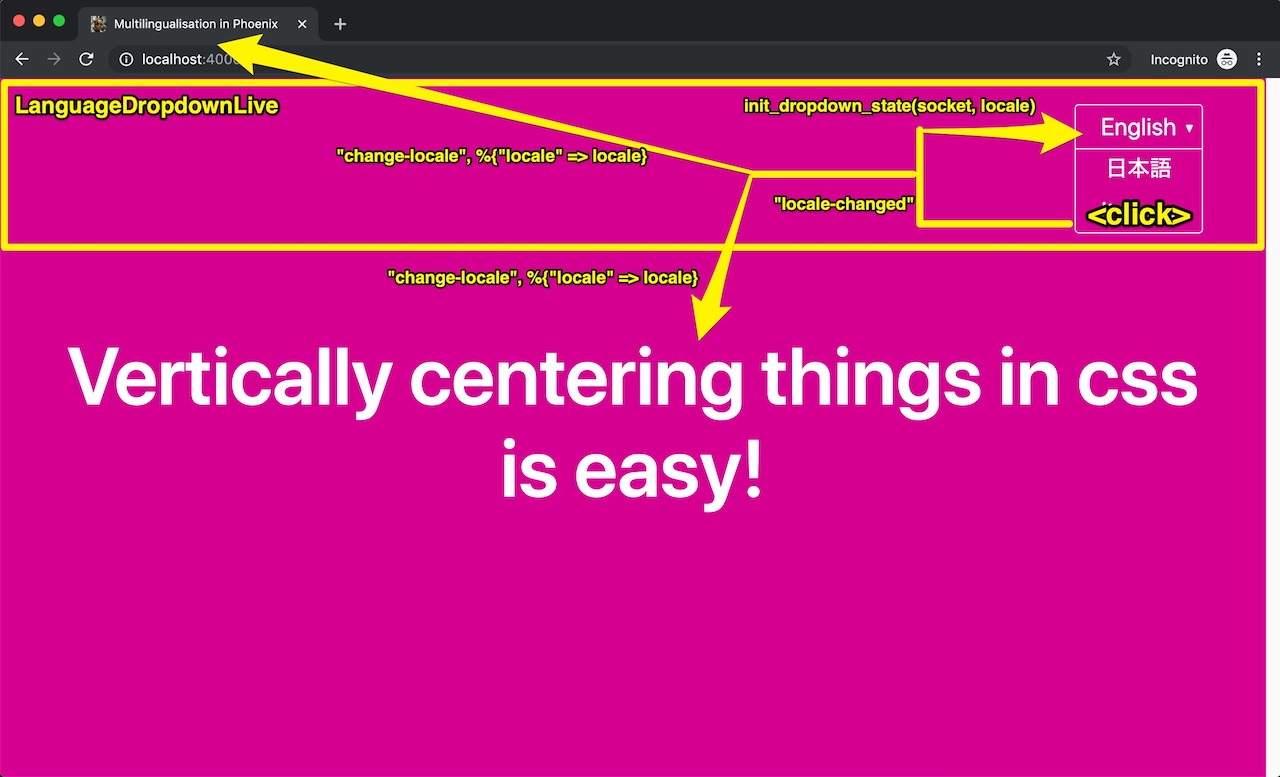
The final message that LanguageDropdownLive needs to deal with, is the "hide-dropdown" message that it would receive when a click is registered on PageLive. The implementation for this is the same as handling the "hide" message we did earlier, so let’s just include it in for the final version of the full LanguageDropdownLive code:
lib/phx_i18n_example_web/live/language_dropdown_live.ex
defmodule PhxI18nExampleWeb.LanguageDropdownLive do
use Phoenix.LiveView
alias PhxI18nExampleWeb.{Endpoint, LanguageDropdownView}
@locales Gettext.known_locales(PhxI18nExampleWeb.Gettext)
@locale_changes "locale-changes"
@dropdown_changes "dropdown-changes"
def mount(%{locale: locale}, socket) do
Endpoint.subscribe(@dropdown_changes)
socket = init_dropdown_state(socket, locale)
{:ok, socket}
end
def render(assigns) do
LanguageDropdownView.render("language_dropdown.html", assigns)
end
def handle_event("hide", _value, socket) do
socket = assign(socket, :show_available_locales, false)
{:noreply, socket}
end
def handle_event("toggle", _value, socket) do
%{assigns: %{show_available_locales: show_available_locales}} = socket
socket = assign(socket, :show_available_locales, !show_available_locales)
{:noreply, socket}
end
def handle_event("locale-changed", %{"locale" => locale}, socket) do
Endpoint.broadcast_from(self(), @locale_changes, "change-locale", %{
locale: locale
})
socket = init_dropdown_state(socket, locale)
{:noreply, socket}
end
def handle_info(%{event: "hide-dropdown"}, socket) do
socket = assign(socket, :show_available_locales, false)
{:noreply, socket}
end
defp init_dropdown_state(socket, locale) do
selectable_locales = List.delete(@locales, locale)
assign(
socket,
%{
locale: locale,
selectable_locales: selectable_locales,
show_available_locales: false
}
)
end
end
We have now completed our LiveView implementation, and the application’s final form ![]() ! Open up a browser and give it and try, and hopefully you should see or feel no discernable difference between the Javascript takeover version of the application and the LiveView version.
! Open up a browser and give it and try, and hopefully you should see or feel no discernable difference between the Javascript takeover version of the application and the LiveView version.
You can find the code for this iteration of the application in this post’s companion Github repo on the 04-liveview branch.
Conclusion
So, after all this, was using LiveView to implement locale switching worth it? As a toy application to learn all about and get more of an intuitive feel for LiveView, absolutely! How about a production application? Now that I have spent so much time on this application, chances are the next time I do a LiveView project, development may not take me quite as long, so, maybe! Is it overkill for functionality like locale switching, which will likely be done very rarely? Probably!
Regardless of the actual value of this example application, I think that on my next Phoenix project, where possible, I will very likely be reaching for LiveView first before Javascript, and only resort to the Javascript when I hit the limits of what LiveView is able to do, wherever they happen to be.
Update (18 January 2020)
It was brought to my attention that the application, as it stands, has a bit of an issue. Open up the application in two separate browsers and see if you can spot it.
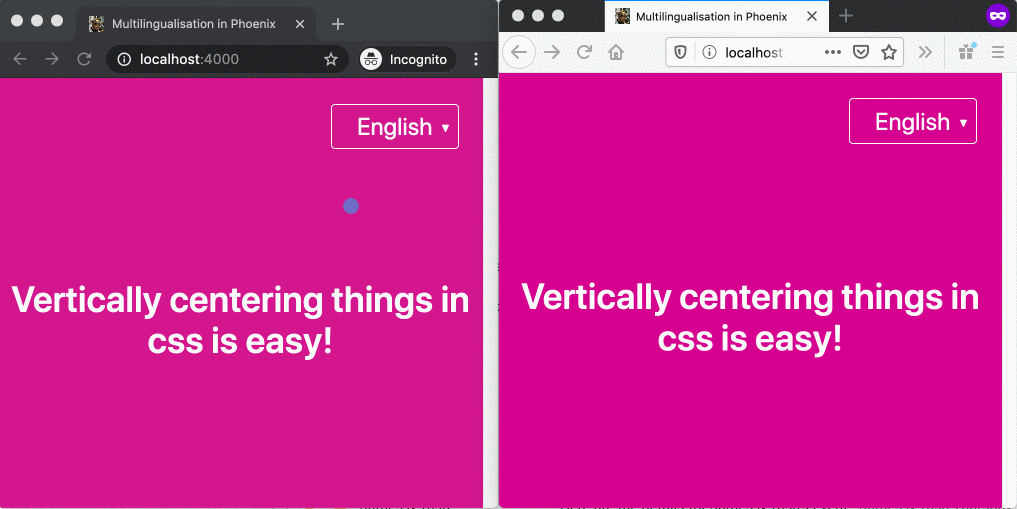
That’s right: if you change the locale in one browser, then the locale changes for every client that is using the application. If we are using the application at the same time, I really should not be able to control what language you are viewing, and vice versa.
Furthermore, the language dropdown menu itself is not aware of what is going on because it is not listening out for locale-change events; it believes that it is the sole source of locale-change events, and not some other parallel-universe language dropdown menu that is reaching across its barrier and pulling the language rug out from underneath it.
So, what is the cause of this issue?
Static PubSub Channels
Currently, all the LiveView files are broadcasting and subscribing to exactly the same static channels. For example:
lib/phx_i18n_example_web/live/language_dropdown_live.ex
defmodule PhxI18nExampleWeb.LanguageDropdownLive do
# ...
@locale_changes "locale-changes"
@dropdown_changes "dropdown-changes"
def mount(%{locale: locale}, socket) do
Endpoint.subscribe(@dropdown_changes)
# ...
end
# ...
def handle_event("locale-changed", %{"locale" => locale}, socket) do
Endpoint.broadcast_from(self(), @locale_changes, "change-locale", %{
locale: locale
})
# ..
end
# ...
end
Endpoint.subscribe/1 and Endpoint.broadcast_from/4 are using only the static string channel names defined in the @locale_changes and @dropdown_changes module attributes. Consequently, all clients are subscribing and broadcasting message changes to the same channel, resulting in all the unexpected state sharing issues.
Arbitrary User IDs
This kind of behaviour might be desired in some situations, but for this application, we want PubSub actions to be siloed to specific users: channel names should look something like @locale_changes <> id, where id is some identifier unique to the browser client or user, so that PubSub messages and updates would only apply for that client/user.
In some Phoenix applications, this could take the form of the database ID of a User or Account, but for something as trivial as this application, we do not have a concept of “users” or “accounts”.
So, in the absence of database-backed users with unique IDs, let’s create the next best thing with the lowest barrier to entry, and arbitrarily assign a unique “user_id” to each application browser connection. We will need this ID in both the conn and the session to make sure all the application LiveViews can utilise it. So, let’s handle the user_id problem in a similar way to how we handled the locale: generate it in a Plug.
First, tell the router that we will use a UserIdPlug in the browser pipeline:
lib/phx_i18n_example_web/router.ex
defmodule PhxI18nExampleWeb.Router do
use PhxI18nExampleWeb, :router
alias PhxI18nExampleWeb.{LocalePlug, UserIdPlug}
pipeline :browser do
# ...
plug UserIdPlug
plug LocalePlug
end
# ...
end
Next define the plug: generate a random ID and assign it to the conn and the session:
lib/phx_i18n_example_web/plugs/user_id_plug.ex
defmodule PhxI18nExampleWeb.UserIdPlug do
alias Plug.Conn
@behaviour Plug
@num_bytes 16
@impl Plug
def init(_opts), do: nil
@impl Plug
def call(conn, _opts) do
random_id = generate_random_id()
conn
|> Conn.assign(:user_id, random_id)
|> Conn.put_session(:user_id, random_id)
end
defp generate_random_id do
@num_bytes
|> :crypto.strong_rand_bytes()
|> Base.encode64()
end
end
Then, provide the user_id to the LiveView session:
lib/phx_i18n_example_web/router.ex
defmodule PhxI18nExampleWeb.Router do
# ...
scope "/", PhxI18nExampleWeb do
pipe_through :browser
live "/", PageLive, session: [:locale, :user_id]
end
end
The user_id is now available in PageLive via the session, and in the app.html.eex layout via the conn, so we can pass it off to TitleLive and LanguageDropdownLive. Let’s first make sure that the LiveViews rendered from the layout get given a user_id:
lib/phx_i18n_example_web/templates/layout/app.html.eex
<!DOCTYPE html>
<html lang="en">
<head>
<!-- ... -->
<%= live_render @conn,
TitleLive,
session: %{locale: @locale, user_id: @user_id} %>
<!-- ... -->
</head>
<body class="<%= body() %>">
<%= live_render @conn,
LanguageDropdownLive,
session: %{locale: @locale, user_id: @user_id} %>
<!-- ... -->
</body>
</html>
Now, for each LiveView, add the user_id to the static PubSub channel names, as well as make any other minor adjustments to make everything work:
lib/phx_i18n_example_web/live/title_live.ex
defmodule PhxI18nExampleWeb.TitleLive do
# ...
@locale_changes "locale-changes:"
def mount(%{locale: locale, user_id: user_id}, socket) do
Endpoint.subscribe(@locale_changes <> user_id)
socket = assign(socket, :locale, locale)
{:ok, socket}
end
# ...
end
lib/phx_i18n_example_web/live/language_dropdown_live.ex
defmodule PhxI18nExampleWeb.LanguageDropdownLive do
# ...
@locale_changes "locale-changes:"
@dropdown_changes "dropdown-changes:"
def mount(%{locale: locale, user_id: user_id}, socket) do
Endpoint.subscribe(@dropdown_changes <> user_id)
state = init_state(locale, user_id)
socket = assign(socket, state)
{:ok, socket}
end
# ...
def handle_event("locale-changed", %{"locale" => locale}, socket) do
Endpoint.broadcast_from(
self(),
@locale_changes <> socket.assigns.user_id,
"change-locale",
%{locale: locale}
)
state = init_dropdown_state(locale)
socket = assign(socket, state)
{:noreply, socket}
end
defp init_state(locale, user_id) do
Map.merge(
%{user_id: user_id},
init_dropdown_state(locale)
)
end
defp init_dropdown_state(locale) do
selectable_locales = List.delete(@locales, locale)
%{
locale: locale,
selectable_locales: selectable_locales,
show_available_locales: false
}
end
end
lib/phx_i18n_example_web/live/page_live.ex
defmodule PhxI18nExampleWeb.PageLive do
# ...
@locale_changes "locale-changes:"
@dropdown_changes "dropdown-changes:"
def mount(%{locale: locale, user_id: user_id}, socket) do
Endpoint.subscribe(@locale_changes <> user_id)
socket = assign(socket, locale: locale, user_id: user_id)
{:ok, socket}
end
def handle_event("hide-dropdown", _value, socket) do
Endpoint.broadcast_from(
self(),
@dropdown_changes <> socket.assigns.user_id,
"hide-dropdown",
%{}
)
{:noreply, socket}
end
def handle_info(%{event: "change-locale", payload: payload}, socket) do
socket = assign(socket, :locale, payload.locale)
{:noreply, socket}
end
end
Note that user_id is deliberately not passed into the socket in TitleLive, since it is only ever used in mount/2 when setting up its subscriptions, as opposed to the other LiveViews which need the user_id when they send out broadcasts.
Now, when you use the application with multiple browsers, you should see that it works as expected:
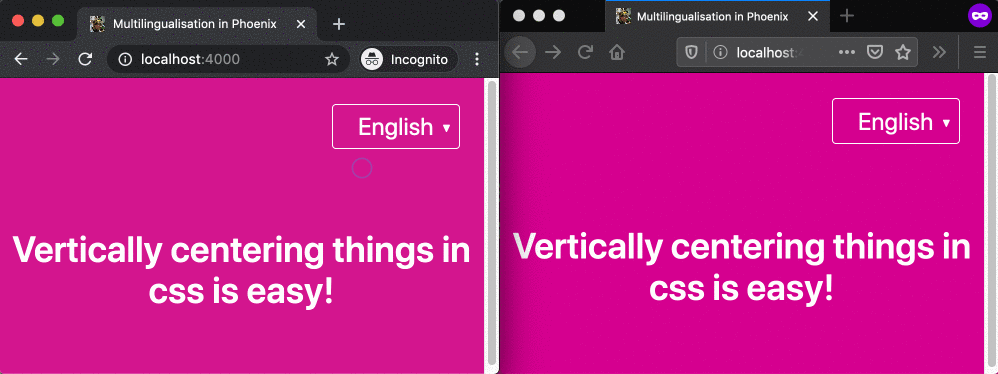
You can find the code for this iteration of the application in this post’s companion Github repo on the 05-liveview-fix branch.
Follow the next steps of this application’s journey in Internationalisation with Phoenix LiveComponents!



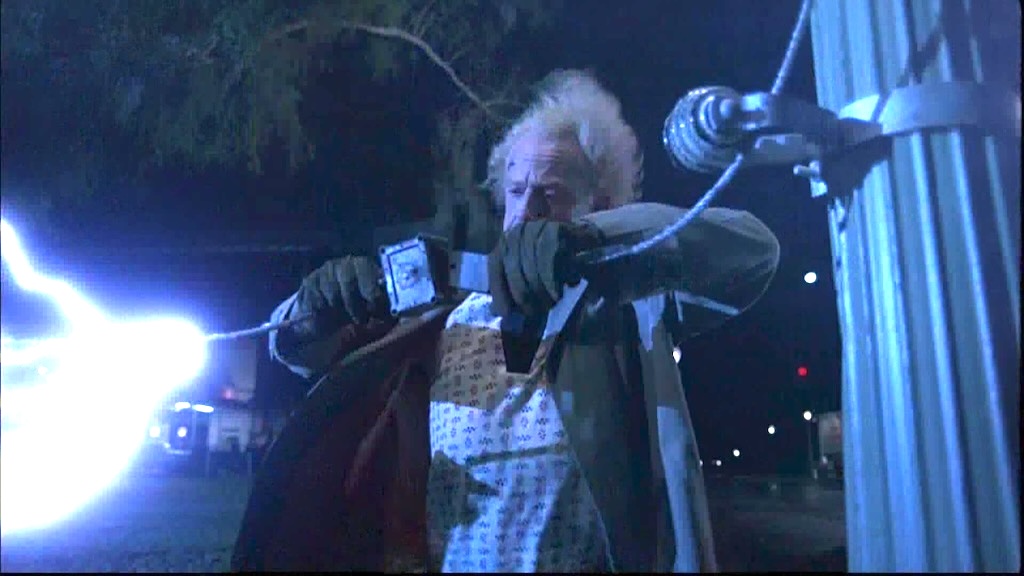

Leave a comment